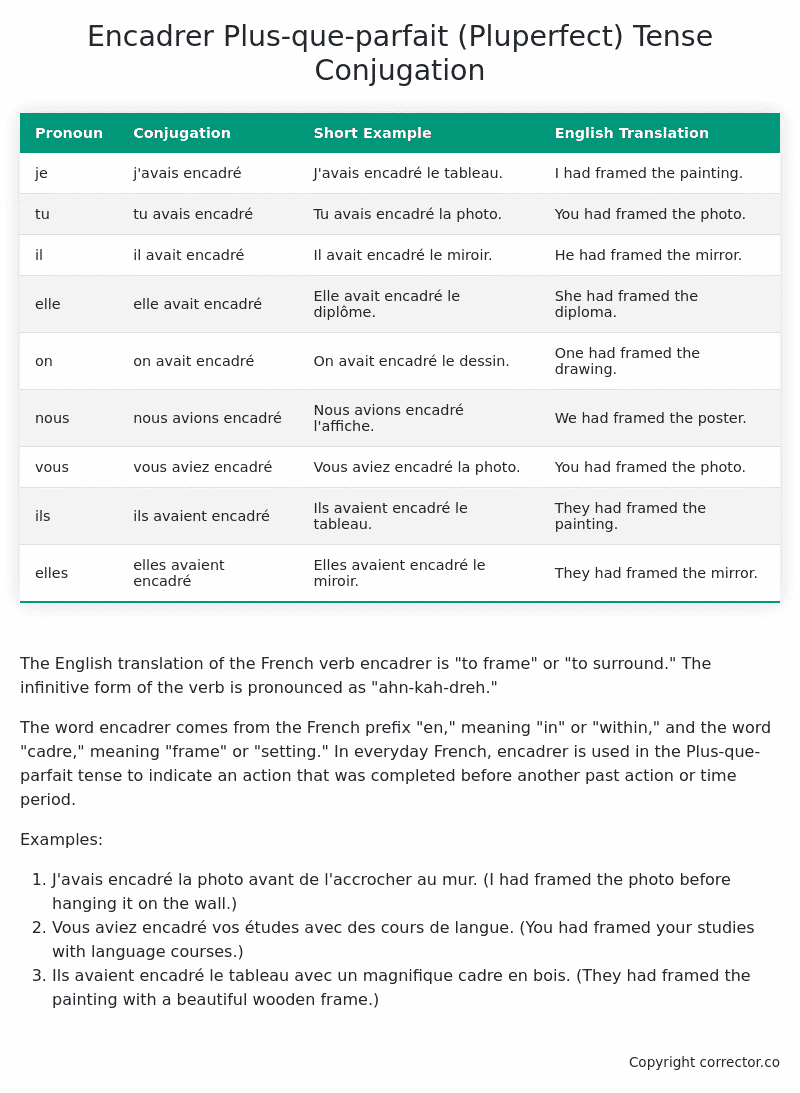Plus-que-parfait (Pluperfect) Tense Conjugation of the French Verb encadrer
Introduction to the verb encadrer
The English translation of the French verb encadrer is “to frame” or “to surround.” The infinitive form of the verb is pronounced as “ahn-kah-dreh.”
The word encadrer comes from the French prefix “en,” meaning “in” or “within,” and the word “cadre,” meaning “frame” or “setting.” In everyday French, encadrer is used in the Plus-que-parfait tense to indicate an action that was completed before another past action or time period.
Examples:
- J’avais encadré la photo avant de l’accrocher au mur. (I had framed the photo before hanging it on the wall.)
- Vous aviez encadré vos études avec des cours de langue. (You had framed your studies with language courses.)
- Ils avaient encadré le tableau avec un magnifique cadre en bois. (They had framed the painting with a beautiful wooden frame.)
Table of the Plus-que-parfait (Pluperfect) Tense Conjugation of encadrer
| Pronoun | Conjugation | Short Example | English Translation |
|---|---|---|---|
| je | j’avais encadré | J’avais encadré le tableau. | I had framed the painting. |
| tu | tu avais encadré | Tu avais encadré la photo. | You had framed the photo. |
| il | il avait encadré | Il avait encadré le miroir. | He had framed the mirror. |
| elle | elle avait encadré | Elle avait encadré le diplôme. | She had framed the diploma. |
| on | on avait encadré | On avait encadré le dessin. | One had framed the drawing. |
| nous | nous avions encadré | Nous avions encadré l’affiche. | We had framed the poster. |
| vous | vous aviez encadré | Vous aviez encadré la photo. | You had framed the photo. |
| ils | ils avaient encadré | Ils avaient encadré le tableau. | They had framed the painting. |
| elles | elles avaient encadré | Elles avaient encadré le miroir. | They had framed the mirror. |
Other Conjugations for Encadrer.
Le Present (Present Tense) Conjugation of the French Verb encadrer
Imparfait (Imperfect) Tense Conjugation of the French Verb encadrer
Passé Simple (Simple Past) Tense Conjugation of the French Verb encadrer
Passé Composé (Present Perfect) Tense Conjugation of the French Verb encadrer
Futur Simple (Simple Future) Tense Conjugation of the French Verb encadrer
Futur Proche (Near Future) Tense Conjugation of the French Verb encadrer
Plus-que-parfait (Pluperfect) Tense Conjugation of the French Verb encadrer (this article)
Passé Antérieur (Past Anterior) Tense Conjugation of the French Verb encadrer
Futur Antérieur (Future Anterior) Tense Conjugation of the French Verb encadrer
Subjonctif Présent (Subjunctive Present) Tense Conjugation of the French Verb encadrer
Subjonctif Passé (Subjunctive Past) Tense Conjugation of the French Verb encadrer
Subjonctif Imparfait (Subjunctive Imperfect) Tense Conjugation of the French Verb encadrer
Subjonctif Plus-que-parfait (Subjunctive Pluperfect) Tense Conjugation of the French Verb encadrer
Conditionnel Présent (Conditional Present) Tense Conjugation of the French Verb encadrer
Conditionnel Passé (Conditional Past) Tense Conjugation of the French Verb encadrer
L’impératif Présent (Imperative Present) Tense Conjugation of the French Verb encadrer
L’infinitif Présent (Infinitive Present) Tense Conjugation of the French Verb encadrer
Struggling with French verbs or the language in general? Why not use our free French Grammar Checker – no registration required!
Get a FREE Download Study Sheet of this Conjugation 🔥
Simply right click the image below, click “save image” and get your free reference for the encadrer Plus-que-parfait tense conjugation!

Encadrer – About the French Plus-que-parfait (Pluperfect) Tense
Tense Formation
Common everyday usage patterns
Sequencing of past events
Background information
Hypothetical or reported speech
Interactions with other tenses
Summary
I hope you enjoyed this article on the verb encadrer. Still in a learning mood? Check out another TOTALLY random French verb conjugation!


